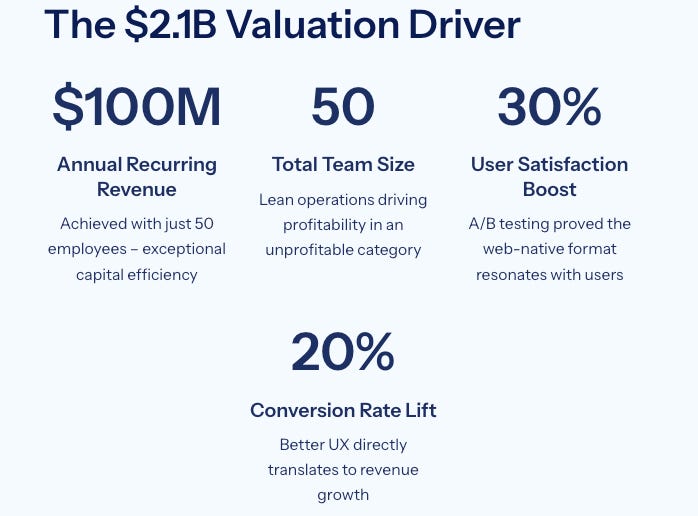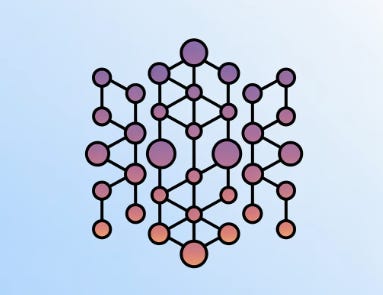Back in June, I wrote about how PowerPoint kills creativity through forced context-switching. My solution? Stay in Claude.AI’s artifact system, generate React slideshows, dodge the whole presentation software problem.
Then I actually used Gamma. For real work. Fifty-plus presentations since June.
And it’s... complicated.
Here’s what happened: I needed client decks fast. The Claude.AI artifact approach works great for internal stuff, but clients expect actual presentation files they can edit. So I started having Claude.AI generate Gamma-optimized prompts from my writing, then feeding those into Gamma’s AI.
The workflow stuck because it actually works.
The Workflow That Accidentally Solved My Problem
My process now looks like this: Write the core content in Claude.AI (where I’m already thinking), ask Claude to “generate a Gamma-optimized prompt from this,” paste that into Gamma, wait about 30 seconds.
What comes out? Surprisingly good first drafts.
Gamma’s gotten noticeably better at data layouts. Early on, every deck looked identical—same card structures, same visual hierarchy, same boring templates. Now there’s actual variety. Charts that make sense. Diagrams that don’t look like they came from a 2010 PowerPoint template pack.
The image generation is genuinely fast. Much faster than DALL-E 3, which matters when you’re iterating on client deliverables with tight deadlines. Quality’s solid for presentation purposes—not fine art, but better than stock photos.
Speed became the killer feature. From prompt to reviewable deck in under a minute. For comparison, building the same deck manually in PowerPoint? Easily an hour. Even my Claude artifact approach took 15-20 minutes of tweaking.
Gamma also has a new agent which solves the biggest problem with decks — one way flow (the difficulty of changing content in slide format). The agent is basically a format-aware LLM that can make prompt-driven changes ON THE FLY, respecting the structure of the deck. It’s magic. Try this in Powerpoint: “Let’s fix “We” vs “I”. I am the author of the proposal, and should be shown for any action in the proposal. ‘We’ can be used to imply that implementing action is a team effort.”
What Still Sucks
Themes remain formulaic. You can spot a Gamma deck instantly. That “modern, clean, professional” aesthetic they’re known for? It’s also their limitation. Every deck feels like it came from the same design system because, well, it did.
Custom branding takes work. Not impossible, but friction exists. Clients with strict brand guidelines require manual adjustment of colors, fonts, layouts. The AI doesn’t learn your brand preferences across presentations.
Export compatibility has gotten better but still breaks occasionally. PowerPoint imports lose some formatting. Google Slides handles it reasonably well. PDF works perfectly, which is what most clients care about anyway.
The big context-switching problem from my original article? Still there. I’m still developing ideas in Claude.AI, then moving to Gamma to package them. Better packaging doesn’t solve the fundamental workflow break.
The $68M Series B Changes Nothing (And Everything)
Gamma just raised $68 million at a $2.1 billion valuation. Andreessen Horowitz led the round. The company hit $100 million ARR with only 50 employees and claims 70 million users.
Those numbers matter. Not because they make Gamma’s product better, but because they signal where the market’s going.
AI-powered presentation tools aren’t a feature anymore. They’re a category. The $2.5 billion subsegment of presentation software is growing at 25% annually. Traditional slide software (PowerPoint, Google Slides, Keynote) collectively represent $7.8 billion, but they’re legacy infrastructure now.
What’s interesting: Gamma reached profitability and stayed there for 15+ months before this raise. That’s rare in AI tools, where most companies burn through capital chasing growth. The economics actually work.
The funding goes toward addressing weaknesses—customer support infrastructure (Trustpilot shows a brutal 2.1/5 rating) and enterprise features. The $20 million secondary component gave early employees liquidity, which suggests the founders are playing the long game rather than rushing to exit.
Multi-Model Orchestration Actually Matters
Here’s the technical piece worth understanding: Gamma doesn’t use a single AI model. They orchestrate across multiple models—primarily Claude Sonnet and Gemini Flash, with OpenAI tested regularly but not favored.
This matters because different models excel at different tasks. Claude Sonnet handles complex content generation and structural thinking. Gemini Flash provides cost-efficient image generation and quick iterations. The company runs hundreds of A/B tests to optimize model selection per task.
When they tested Claude 3 Haiku, it delivered 30% better user satisfaction and 20% higher free-to-paid conversion. That’s not incremental—that’s the difference between sustainable business and burning capital.
The architecture uses block-based HTML instead of traditional slides. More responsive, more web-native, more flexible than the slide metaphor PowerPoint established 40 years ago. This is what I meant in my original article about dodging the medium that kills flow—Gamma at least tries to escape the rigid slide structure.
Competitive Reality: Nobody Else Gets Close
I’ve tested the alternatives. Beautiful.ai focuses on design automation with limited AI content generation. Pricing starts at $12/month but no free tier, positioning it as premium design-first. Their “Smart Slides” auto-adjust layouts nicely, but you’re still building content manually.
Tome raised $81 million and hit 10 million signups fast, but the product feels unfinished. $16-20/month gets you narrative-focused presentations with PDF-only export. The dark-mode-default aesthetic works for pitch decks but fails for client-facing business presentations. Limited to 400-character prompts, so complex decks require extensive manual work.
Canva offers Magic Design for Presentations as one feature among dozens. The $10/month pricing undercuts everyone, but presentations aren’t the focus. Export compatibility to PowerPoint breaks constantly. Format preservation? Forget it.
Microsoft Copilot costs $66-87/month minimum (Copilot plus Microsoft 365 E3/E5 licensing). Enterprise security and Microsoft Graph integration appeal to large organizations, but the economics are brutal for individuals or small teams. Plus, no transitions, videos, or tables in AI-generated slides initially. English-only at launch. Accuracy requires manual review.
Pitch positions as collaboration-first with basic AI (”Start with AI” limited to 400 characters). $20/month per user, $80/month for business tier. Excels at real-time collaboration and analytics, but the AI feels like an afterthought.
Gamma sits in the sweet spot: $8-15/month with genuinely useful free tier (400 one-time AI credits). Better AI content generation than anyone except Microsoft, but without enterprise complexity or costs. Multi-model orchestration surpasses all competitors except Microsoft, and Gamma’s web-native format differentiates from traditional slides.
A Concerning Trust Problem
Here’s what concerns me: Gamma’s Trustpilot rating of 2.1/5 across 39+ reviews represents a reputational risk for a B2B tool claiming 70 million users.
Common complaints? Customer support ignoring refund requests for weeks, AI-generated automated responses with no human follow-up, image quality described as “chaotic and glitchy” for professional use, promised premium features not delivered after payment.
The volume of negative reviews remains small relative to the claimed user base, suggesting either sampling bias toward extremely dissatisfied customers or concerning patterns in user experience that could block enterprise adoption.
For context: Product Hunt rates Gamma 4.6-4.9/5 across 170+ reviews. G2 shows 4.3/5. Microsoft Store rates 4.2-4.3/5. The polarization between professional users (who love it) and dissatisfied customers (who hate customer support) creates risk.
The Series B funding presumably addresses this—50 employees can’t support 70 million users effectively. Scaling customer support infrastructure takes capital and systems, both of which this round should provide.
My Original Critique Stands (Mostly)
Go back to “I Hate PowerPoint.” My argument: any context switch from brainstorming to presenting breaks creative momentum. The medium forces you to chunk ideas into slide formats before the ideas are fully formed.
Gamma doesn’t solve this. You still develop ideas in one place (Claude.AI, docs, notes), then move to Gamma to package them. It’s a better publishing tool, not a thinking tool.
But—and this matters—the workflow I’ve developed minimizes the friction. Claude.AI generates the Gamma prompt from my raw thinking. Gamma builds the deck structure. I review and refine in Gamma rather than rebuilding from scratch.
That’s not elimination of context-switching. It’s reduction of friction within the switch.
The speed advantage matters more than I expected. When you can go from raw ideas to reviewable deck in under two minutes, the context switch feels less disruptive. Not zero, but manageable.
For client work specifically, Gamma solves a real problem: clients expect presentation files, not React component artifacts. The output needs to be editable by non-technical people using familiar tools. Gamma delivers that in a format that imports reasonably well into PowerPoint and Google Slides.
What This Says About AI Presentation Tools
The market validated my “I Hate PowerPoint” thesis in an unexpected way. The problem isn’t PowerPoint itself—it’s the forced chunking of ideas into presentation formats before ideas are fully developed.
AI tools like Gamma reduce the friction of that chunking. They don’t eliminate it.
The $68 million Series B at $2.1 billion valuation signals that investors believe AI-powered presentation generation is a durable category, not a temporary feature. The 25% CAGR growth projection for AI-specific presentation software through 2030 suggests the market expands rather than substitutes.
But here’s what keeps me skeptical: conversational AI interfaces could eliminate standalone presentation tools entirely. Anthropic’s Claude or OpenAI’s ChatGPT could embed presentation generation natively, competing with dedicated tools. Why leave your conversation to generate a deck when the conversation can generate the deck without context-switching?
Gamma’s current advantage—multi-model orchestration, prompt engineering culture, extensive A/B testing—represents a technical moat. But moats erode when platform companies decide to compete directly.
Bottom Line
I’ve created 50+ presentations in Gamma since June. It works. Fast, reasonably good output, improving steadily.
Does it solve the PowerPoint problem? No. It makes the problem more tolerable.
The workflow I’ve developed—Claude.AI for thinking, Claude-generated prompts for Gamma, Gamma for packaging—reduces friction without eliminating the fundamental context switch.
For client-facing work where deliverables need to be presentation files, Gamma beats the alternatives. For internal work or pure creative thinking, my Claude artifact approach still feels cleaner.
The $68 million raise and $2.1 billion valuation validate that AI presentation tools represent a real category with sustainable economics. Gamma’s capital efficiency (reaching this scale on $90 million total raised) and profitability distinguish it from cash-burning competitors.
But the ultimate solution to “I Hate PowerPoint” isn’t better presentation software. It’s eliminating the need to translate ideas into presentation formats at all. When that happens—when conversational AI can deliver the final format without leaving the conversation—tools like Gamma become legacy infrastructure.
For now? Gamma’s the best execution of a flawed category. Which means I’ll keep using it while hoping something better comes along.
Related: I Hate PowerPoint - my original argument about why presentation software kills creative flow, and my follow up first talking about Gamma.







